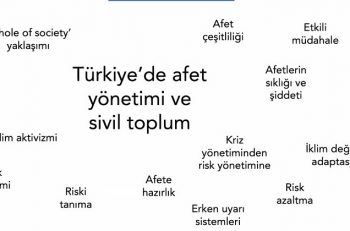Being an NGO Employee in Turkey (3)
The Importance of HR Policies Unstated in Civil Society

Turkey counts over 122 thousand associations and more than 5 thousand foundations, which constitute the so-called 'third sector', employing an estimated 60 thousand salaried employees; however, only 20 NGOs have a Human Resources (HR) department. Funding constraints and the failure to grasp the importance of HR policies constitute obstacles before the rights and career prospects of NGO employees.
With the increase in project-based work in recent years, there are heated debates as to whether the civil society really forms a ‘sector’, and the problems and grievances of the employees and volunteers in this field are frequently brought to the public agenda. According to current figures out of a total of 28 million registered employees in the country, NGO employees number 60 thousand. Yet, their problems are considered important neither in the agenda of decision makers, nor that of the civil society. Although various grievances are expressed through revelations on social media, these are forgotten shortly after a few news articles.
However, many problems faced by private and public sector employees, such as mobbing, also beset the NGOs, although such issues are not expressed overtly most of the time.
According to official figures, while the number of full-time employees in associations stood at 3,943 in 2006 in Turkey, this figure climbed to 41,189 in 2020. The number of their part-time employees, on the other hand, went up from 616 in 2006 to 4,194 in 2020. Likewise, the number of project-based employees in associations surged from 542 in 2006 to 32,554 in 2020. In parallel to the increase in the number of NGOs, the number of volunteers went up from 1,068 in 2006 to 35,979 in 2020. However, it is estimated that only 20 NGOs have HR departments in Turkey.
There has been a remarkable increase in the number of NGO employees, creating the need for a wise and principled management of human resources, especially in terms of employees’ occupational safety and work conditions. The existing initiatives in this field fail to respond to this need.
The NGO Human Resources Group, established in 2011 by 12 NGOs, which do have HR departments, is the only structure in civil society that contributes in this field. However, there is an increase in issues, which beg for answers and spark debates, parallel to the rise in the number of employees and volunteers.
How can the current situation in civil society be addressed from an HR perspective? Is it possible to compare the civil society and the private sector in terms of HR policies? Should civil society employees be managed with a professional HR approach? What sort of HR policies and employee rights should be formulated in civil society? How can we address the problems and grievances of NGO employees?
In the third part of our series titled Being an NGO Employee in Turkey, we directed these questions to Betül Selcen Özer and Sermin Kağan, who are both active in the NGO Human Resources Group and have managerial experience in civil society.
Human Resources and HR Policies in NGOs
Commenting first on NGOs’ perspective on human resources, Özer and Kağan argue that the main distinction between NGOs and the private sector in terms of HR policies emerges in practice. Both experts consider that NGOs cannot allocate sufficient funds to this field and cannot grasp the importance of HR.
Having worked as a manager and coordinator in civil society for 20 years and served as the General Manager of Tohum Autism Foundation until last year, Betül Selcen Özer states that the NGOs, which she describes as the third sector, differ from the public and private sectors in many respects. For Özer, the most salient difference is that the NGOs do not seek profit. Arguing that NGO employees differ from their private sector counterparts in terms of their perspective on wages and rights, Özer notes that, as stated by Alper Akyüz in a previous article in our series, NGO employees make a conscious choice to work in this field.
Sermin Kağan, who currently works as a Human Resources Director, is of the same view. Kağan likens NGO employees to “internal combustion engines”, saying, “Their self-motivation skills are very advanced, however, they eventually get exhausted at a certain point.”
Sermin Kağan is currently the mentor of the First Chance Program, launched by Esas Sosyal to support new graduates willing to work as salaried employees in NGOs. Previously, Kağan worked as an HR manager in civil society for 20 years, at Educational Volunteers Foundation of Turkey and Tohum Autism Foundation. She argues that there is no conceptual difference between the private sector and civil society in terms of HR functions such as performance evaluation, training and development, remuneration and side benefits.
According to Özer, despite making much progress since the beginning of the 2000s and increasing the number of their employees, the NGOs in Turkey generally do not have an HR department or position, or have established one very recently. Noting that in NGOs without an HR department, it is the finance department which shoulders this burden, Özer states that HR is seen as a luxury among NGOs. Noting that NGOs expect to reach a certain number of employees, a certain budget and size before setting up an HR unit, Kağan states that, struggling to achieve a lot with limited resources, NGOs do not prioritize HR departments.
Considering the exclusion of volunteers from the process as a major problem, Kağan says that human resources in NGOs should not be limited to the professionals and employees falling under the labor law. Kağan puts forth the criticism that the importance of HR is generally not understood by NGOs, and that there are few private sector companies and NGOs which view HR departments as strategic partners.
NGO Human Resources Working Group gave momentum to HR policies in civil society.
Summarizing their views on HR policies in civil society with these words, Özer and Kağan both draw attention to the contributions of the NGO Human Resources Working Group established in 2011 by a number of NGOs. Having pioneered the establishment of the NGO Human Resources Working Group, Kağan explains that the Group was founded in 2011 by 12 NGOs which have at least 25 employees as well as HR departments. The founders comprise large NGOs such as TEGV, TEMA, İKSV, Darüşşafaka, YADA, TOG, ÖRAV, TEV, TESEV and AÇEV. Sabancı Foundation, Greenpeace, Maya Foundation and TİKAV have also joined the group later on.
Kağan emphasizes that the Group, expanding its activities with the participation of new NGOs, acts in line with HR ethics, and adds momentum to the implementation of HR policies in civil society through the contribution of executives with prior experience in the private sector. Özer also suggests that, via the NGO Human Resources Working Group, NGOs can share knowledge and experience, and take major steps so as to outline the HR policies in civil society, as well as to attain and maintain certain standards on rights.
Employee Rights in NGOs Fighting for Survival
Presenting this assessment of the HR approach of NGOs, Özer and Kağan point to the need to take measures concerning employee rights and grasp the importance of HR policies.
Betül Selcen Özer suggests that since civil society is a labor-intensive industry where employees are highly committed, employees’ rights and problems should be discussed openly. However, Özer also notes that NGOs are going through a “real struggle for survival” and as such the conditions of this period and of each NGO ought to be taken into consideration: “In an NGO that is trying to survive through donations, one cannot establish wage policies and side benefits on a par with the private sector.”
Stating that during her managerial career she prioritized the rights and work conditions of NGO employees and that she had the chance to establish an appropriate structure in the NGOs where she worked, Özer makes the following suggestions based on this experience: Discussing some of the unspoken rules of NGOs, modernizing certain practices, and taking protective measures for all employees. Furthermore, Özer also argues that putting the rules in writing, formulating a legal framework, and bringing all employees under its scope would require intensive labor and expertise from an NGO.
Focusing on the rights of private sector and NGO employees from a legal perspective, Kağan says that although both sectors are subject to the same labor legislation, the funding constraints in civil society stand out as the major axis of distinction. For Kağan, NGOs’ human resources are limited due to their funding problems, which prompt NGO employees to work for longer and more intense hours and eventually grow exhausted.
Kağan also assesses the two sectors in terms of wages, and states that it was not possible to make a wage comparison between NGOs and the private sector in the 2010s due to a lack of market data. Yet, with the contributions of the NGO Human Resources Group and other researchers, there is an increasing number of studies on wages, wage policies and practices in civil society. Indicating that over the years, the wages of certain NGO officials have converged towards the level in the private sector, Kağan states nevertheless that NGOs are still lagging behind the private sector in terms of side benefits. She adds that project-based employees, who constitute a large employment category in NGOs, have non-negligible problems such as recurrent job search, and lack of severance pay and annual leave.
The fundamental problem in NGOs is the lack of HR departments or executives in most NGOs; as such, employees lack an interlocutor in this area, thus feel isolated and victimized.
Kağan considers that the position, knowledge, and competence of HR professionals are crucial in protecting civil society employees’ rights and eliminating their grievances, adding that the main problem in NGOs is the lack of HR departments or executives. Arguing that the employees lack an interlocutor in this area and thus feel isolated and victimized, Kağan also suggests that, in order to protect and enhance employee rights, the laws and regulations governing the civil society should be understood accurately and legal consultancy should be sought.
Importantly, Kağan also underlines the fact that the non-hierarchical, horizontal structure of NGOs and the dearth of available positions lead to the absence of career plans akin to those in the private sector. As such, NGO employees cannot make plans for the future and grow discontent.
During the pandemic, NGOs’ funds and leeway were restricted further, rendering the human resources constraints even more evident.
Finally, as regards the impact of the pandemic on NGO employees, Özer and Kağan underscore the fact that the change in the work mode presents challenges for everyone. Indicating that “NGOs’ funds and leeway were restricted further during the pandemic”, Kağan thinks that this has rendered their human resources constraints even more evident. Noting that many NGOs switched to remote work or hybrid solutions during the pandemic, she lists the main hot topics of the day as internal communication issues arising from remote work, and lack of motivation due to the low level of wages arising from the government’s part-time work allowance and in-cash wage support scheme.













Bizi Takip Edin